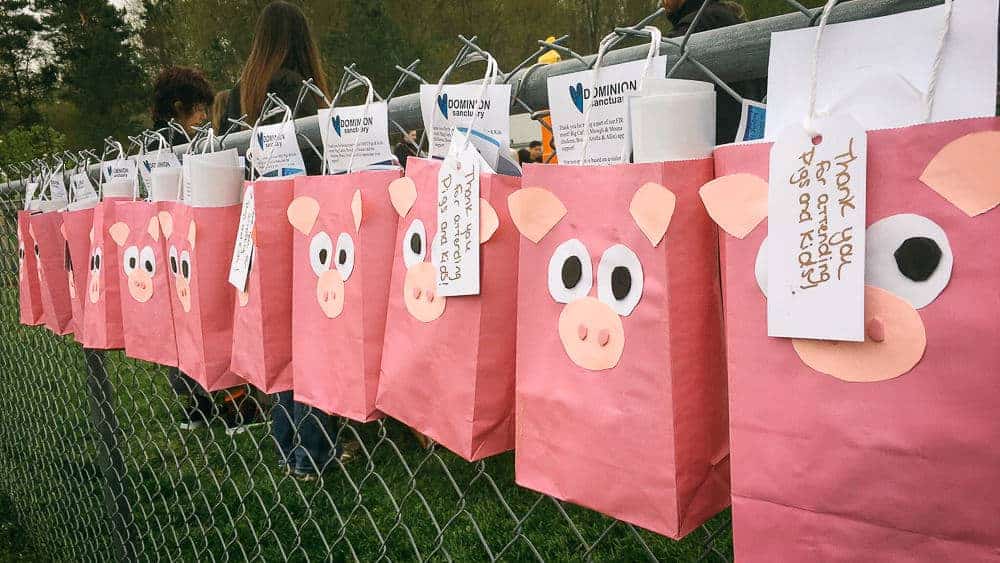
This resource has been fully reviewed and updated by a member of The Open Sanctuary Project team as of October 5, 2022.
Many animal sanctuaries host large events on sanctuary grounds a few times a year in order to connect with folks who may not have previously connected with the sanctuary’s mission or residents before. Events can be an excellent way to spread awareness of your sanctuary in your community, and can also provide opportunities for garnering additional volunteer or financial support in the future. However, a lot of work goes into planning a successful large event at a sanctuary! Many elements and policies must be considered and implemented to ensure your sanctuary’s event is fun and safe for everyone.
Pre-Event Preparations
Long before the event begins at your sanctuary, there are a number of considerations and discussions you’ll want to have together as an organization.
Double Check Your Area’s Zoning And Regulations
Before conducting any major event planning, be sure to review the zoning laws and regional regulations of your sanctuary’s property to learn whether or not there are any restrictions you must abide by or permits you may need to acquire. For instance, some properties may have a limit to the number of folks that can congregate or park there; others may require a special permit for vending, or for food and beverage service on-site. Some regions may even require the hiring of off-duty traffic safety officers if a large enough crowd (or a certain threshold of traffic) is expected to show up in certain areas. Be sure to follow all of the regulations in your area because the consequences could be significant if you’re caught bending the rules! If your sanctuary property is too confined by the rules governing it, you can consider hosting large events off-site.
Inspect Your Insurance

When planning a large event on your sanctuary’s grounds, it’s important to comba fleshy crest on the head of the domestic chicken and other domesticated birds through your organization’s insurance policy and look for any limitations or exclusions in coverage that might exist for event purposes. For instance, some insurance may not cover special events or vendors on-site (or even public visitors at all) while other insurance may have a number of exemptions for guest vehicles. If necessary, consider purchasing supplementary event insurance as extra protection! Typically, one day’s worth of supplemental insurance isn’t too costly, especially compared to the alternative in the event you get into trouble.
Consider Your Neighbors
If your sanctuary is close to others living or working nearby, it’s a good idea to inform them of your upcoming event. You might even invite them if it seems appropriate, but always being mindful of the noise your event generates, especially if the event is early in the morning or later in the afternoon. You should also give them your organization’s contact information, such as a staff member’s phone number, so they can get in touch if they have any concerns during the event that can be peacefully resolved. Although your neighbors might not entirely understand your organization’s mission or philosophy, creating friction or hostility with them is never productive in the long-run!
Think About Your Staffing And Volunteer Needs
Hosting a large event, especially with many members of the public who might not be aware of your mission and policies, means you will need to rely heavily on staff and volunteer help to ensure that your residents and facilities are safe, facilitate respectful interactions with residents at all times, help coordinate parking and check-ins, and make sure all sanctuary policies are maintained throughout the event. You will likely need quite a few more folks to help out than you might have first envisioned if you have never hosted a big event on the property before. Think carefully about your estimated crowd size and your specific needs when soliciting for help from your community. Volunteers may also need specific training before the event and guidance to ensure that the activities go smoothly and safely. If you are frequently relying upon large volunteer pools for events throughout the year, consider looking into hiring a volunteer manager down the line.
Pre-Registration Preparedness
Even if your event is completely free to the public, it can be very helpful to encourage interested visitors to sign up for your event, either via an email RSVP or a free web service. This way, you can have a rough idea of how many folks you can expect to have on your sanctuary grounds, or in order to cap visitor registration early if space is limited. RSVPs can also be useful if you are serving food and beverages, or having vendors provide food on-site to ensure that an appropriate amount of staffing and supplies are on-hand to make the experience positive for everyone.
Make Some Marketing Materials

Nobody will come to your event if nobody knows about it! Consider making a memorable theme and name for your event and be sure to find a few different methods to tell the public about it. Your event’s advertising should include some basic features of the event, including what they might expect during the festivities, as well as the event’s accessibility accommodations, rules, and policies, such as a closed-toed shoe policy or a plant-based food policy.
You’ll want to use a number of marketing channels to help folks find out about your event, including:
- Colorful flyers posted around your community in approved areas
- Social media event invitations and updates leading up to the event date
- Advertising the event prominently on your sanctuary’s website
- Sharing the details of the event via word-of-mouth throughout your volunteer community
Be sure to keep RSVP’d attendees updated if anything about your event changes or if the event gets postponed!
Parking Planning

Unless you’re planning to run a shuttle bus system to and from your sanctuary event, you’ll likely have to make room on your property for additional parking, particularly if you’re expecting a big crowd. Often, this can be a huge undertaking in itself! With the help of volunteers, making an appropriate parking management system that includes accommodations for disabled folks is critical to prevent bottlenecks, traffic, and frustrated visitors. Take a good look at your available property and try to identify the best place to fit more vehicles in a way that won’t negatively impact sanctuary operations, or tear up pasture too significantly if pasture space is the only option. Traffic cones, clear signage, and caution tape are very helpful!
Restroom Readiness
Once you have a good idea of how many folks are expected to show up to your event, you’ll want to ensure that there is an adequate number of restrooms on your property, especially if there will be any food or beverages served on-site. Depending on your location, there may be a local company that could drop off and pick up portable restrooms for special events. If you are expecting a very large amount of people over a long period of time, you can use a porta potty chart to determine exactly how many portable restrooms you’ll need to keep visitors happy! If you are expecting a small crowd and have existing restroom facilities, you may be able to get away without renting additional restrooms, but make sure your restrooms are well-stocked and clean for the duration of the event.
Think Trash

If your event is likely to generate waste (i.e. food and beverage disposables), make sure to have a plan in place. Some waste disposal or recycling companies offer temporary trash, recycling, and even compost stations that you can pick up and drop off for a nominal fee, which can be a great way to manage waste at a big event without having a big cleanup at the end of the day. Separating recyclables and compostables can be a great way to reduce your event’s environmental impact, though you will likely need to station a volunteer or staff member near these waste sorting stations to help visitors put the right waste type in the right bins! Also keep in mind that many compostable containers cannot be put into a home or sanctuary compost pile and must be sent to a commercial compost facility. Ideally, any way you can reduce the generation of waste is always the most environmentally-friendly practice. For more information on eco-friendly practices for your animal sanctuary, check out our resource here!
Vendor Vetting
Your event could potentially include vendors of many kinds, be it plant-based food trucks, a catering company, a musician, or even a compassionate apparel shop! When working with vendors, it’s important to have a signed contractual agreement that defines the scope of their services, what will be expected of them, and the policies they must follow on-site at your sanctuary. Some sanctuaries may require that all food vendors utilize compostable or recyclable containers to reduce waste, others might request that vendors split a percentage of revenue with the sanctuary as a fundraising opportunity. Regardless of what agreement you come to with your vendors, make sure that everything is well-communicated long before the event begins. It’s also helpful to update vendors on the number of people you expect to show up so they can have an appropriate amount of supplies on-hand.
Weather Wariness
It’s a good idea to have plans in place for the various weather scenarios in your region. For instance, if your sanctuary is prone to high winds, have tie-down straps, sandbags, or other heavy objects at the ready on the day of the event to keep any tents or canopies from flying away. You can also stock extra sandbags for vendors with tents. If there’s a possibility for rain or snow, is there an adequate amount of shelter to protect guests? It’s important to inform potential guests how the event will be impacted by unexpected weather. Many sanctuaries host events rain or shine, and suggest guests bring appropriate clothing.
In anticipation of possible poor weather, conduct a weather safety check, making sure that you have de-icing materials and snow shovels at the ready. It’s also a good idea to make sure mud won’t pool where you plan on parking visitor vehicles, and that any tree branches that could potentially break off in a windstorm are appropriately trimmed.
Assess Your Accessibility
When bringing a large number of guests onto your property, think about how you can accommodate attendees who may have disabilities. If your organization is incorporated in the United States, you’ll have to follow the Americans With Disabilities Act. Regardless of your need to follow that specific law, accessibility considerations make everyone’s experiences more pleasant! Consider reserving some disability-accessible parking spaces near the entrance to the event, making paths as smooth and rock-free as possible (and marking them as more accessible if appropriate), and ensuring that some, if not all, restrooms on-site will be accessible.
Visitors who have service animals in the United States must have their needs accommodated per the Americans With Disabilities Act. Think about how you’ll accommodate these visitors and their service animals while considering your residents’ needs and safety.
Whatever the accessibility status of your event or activities are, it can be helpful to list the accommodations and potential accessibility barriers that visitors may face somewhere in your event’s marketing materials or on your website to help everyone make an informed decision on whether they would feel comfortable attending.
Check out our sanctuary accessibility resources on ADA compliance, accommodations for Deaf and hard of hearing community members, accommodations for blind and visually disabled community members, and accommodations for folks with physical disabilities for additional considerations and other ways to create a more inclusive and welcoming environment at your sanctuary!
Companion Animal Considerations
Non-service companion animals should be addressed in your event policies. Most sanctuaries typically prohibit companion animals on their grounds to keep both companion animals and residents safe and comfortable.
Check Your Contingencies
Pre-event planning is a good time to review your organization’s contingency policies (especially as they pertain to members of the public), and make all of them clear to everyone involved in the facilitation and management of the event. Think about specific things that could possibly go wrong in the course of the activities you have planned and have a plan to address them, should they arise. Events can be hectic, and it’s always better to have an accessible plan that never gets used instead of having to manage a problem on the fly! Check out our resource on sanctuary contingency planning here.
Go Over Your Grounds
The day or morning before any visitors set foot on your sanctuary’s grounds, you should conduct a thorough sweep through of any parts of the property that visitors may end up on. All fences, gates, and latches should be secure and checked for operability, and any area that is off-limits to visitors should either be stationed by a volunteer or staff member, or should have clear signage stating that visitors cannot go there. All potentially hazardous tools, equipment, and supplies should be safely locked away. If you are using a digital or web-based check-in system on-site, be sure to check all of the technology prior to the arrival of visitors to make sure there won’t be any headaches if a large crowd tries to check-in simultaneously.
During The Event
You Always Need Waivers
Whenever anyone is on-site at your animal sanctuary, most especially during more hectic times like large events, ensure that everyone on the property signs a visitor waiver, including a prominently-worded and displayed photo and video release section should you wish to share an event recap later with your supporters! A waiver could be signed either beforehand (some event sign-up websites include a system to facilitate signing a waiver), or on-site before guests enter any sensitive areas. It can be valuable to ask for contact information during the check-in process so you can reach these new visitors in the future or have them sign up for your organization’s newsletter, though collecting this additional information on-site as a line forms could potentially slow down the check-in process.
Check out our resource on creating a waiver for your visitors here!
Keep The Water Flowing
Generally, you should plan to have at least one water station available for visitors, especially on warmer or sunnier days at a big sanctuary event. Keeping potable water easily accessible can greatly improve a visitor’s experience and minimize chances of dehydration or sunstroke. You can ask visitors to bring their own water bottles to minimize event waste.
Provide Provisions

Hand sanitizer or handwashing stations should be available in any area where food is served, as well as in any resident living space that the public may have access to. There could be serious liabilities if anyone at the event was to fall ill! Also, consider providing sunscreen as a courtesy to guests who might ask for it, and always keep all areas stocked with first aid kits. All staff and volunteers should know where they are safely kept.
When a large number of guests are on-site for a big event, especially when there are visitors who are unfamiliar with your organization or the mission of animal sanctuaries in general, there is sometimes a misconception around the level of interaction visitors are going to have with your residents. A big event should be a time to double down on your efforts to center your residents’ needs, and always err on the side of caution in their best interest! You should never let the sometimes chaotic atmosphere of an event lead your sanctuary to temporarily act more akin to a petting zoo, nor should any of your event’s activities cause or incidentally promote harm to any residents. Your residents are counting on you to keep them safe and comfortable!
Center Resident Safety
Because a large event may include far more folks than usual on sanctuary grounds, you may want to modify how much resident interaction the public is granted. Perhaps you limit visitors to only a few areas, and prevent anyone from actually entering any resident living spaceThe indoor or outdoor area where an animal resident lives, eats, and rests.. Perhaps you make the decision to prohibit any resident observation or contact whatsoever! Just make sure to clearly communicate your policies to ensure public understanding of what’s acceptable on the day of the event, especially if they’re markedly different than typical tour days.
During the event, if food is served on your property, you’ll need to find a way to make sure that no human food or beverages make it near the residents (and especially that no visitors feed any kind of food to residents unsupervised). You’ll need to ensure that biosecurity protocols are respected (e.g. keep humans away from sensitive quarantine or isolation areas!). Volunteers and staff will be critical for maintaining resident and biosecurity safety at all times during the event.
Event Tour Techniques
Some sanctuaries create modified tours for events that feature specific species or residents, especially if the event is centered around a holiday or occasion that would correlate with their stories (like meeting cowWhile "cow" can be defined to refer exclusively to female cattle, at The Open Sanctuary Project we refer to domesticated cattle of all ages and sexes as "cows." residents on Mother’s Day, or honoring turkeyUnless explicitly mentioned, we are referring to domesticated turkey breeds, not wild turkeys, who may have unique needs not covered by this resource. residents on Thanksgiving). These tours are typically structured in a way that simplifies safe management for staff, and may be shorter so many small groups of visitors can safely attend throughout the event.
Keep Clear Communication
During the event, make sure that communication channels are open at all times among staff and volunteers, using walkie talkies or phones to ensure that everyone is aware of what’s going on, what needs to be modified, and what areas of operation might need more support. If an event is running for a long period of time, volunteers and staff should frequently be given the opportunity to take bathroom, hydration, and meal breaks, and switch positions if necessary.
Consider A Survey
It can be helpful to consider providing a brief, event-specific visitor survey for those who are willing to complete one, perhaps distributed on clipboards if visitors are in line for food or beverages, or at the end of a tour experience. Surveys are an excellent tool for making future events stronger, refining your sanctuary’s programming, and measuring your event’s impact on the community (especially when seeking grants or larger donors). Targeted event surveys especially can help you determine if an event’s specific focus was successfully conveyed to the public, or if improvements can be made in the future. Surveys are most likely to be completed on-site rather than in a follow-up email request after the event. For more information on visitor surveys, check out our resource on crafting visitor surveys here! To read more about sanctuary education program evaluation, check out this resource!
Ask For Support

While so many folks are at your sanctuary, it’s a good time to ask for support! Consider putting out supervised donation boxes (especially at the end of a tour or in other strategic areas), selling merchandise, suggesting that visitors join your membership program, or promoting sponsorships of residents that visitors may respectfully meet. Big events can be a great occasion to fundraise and gain new supporters. For other ways to raise money that you could incorporate into your event, check out our resource here!
After The Event
Once the event is over and the sanctuary is cleaned-up and quiet, it can be really helpful to reflect on the event and conduct a program evaluation. Schedule a time to discuss how the event went with staff and volunteer leadership, preferably within a few days of the event’s conclusion. Discussions and feedback will help you refine your large event practices and policies and ensure that the next one is even better! And remember to express your gratitude to your staff and volunteers for a job well done!








